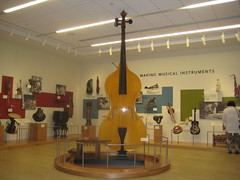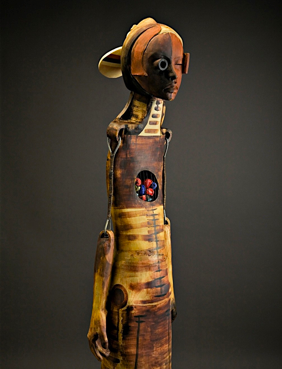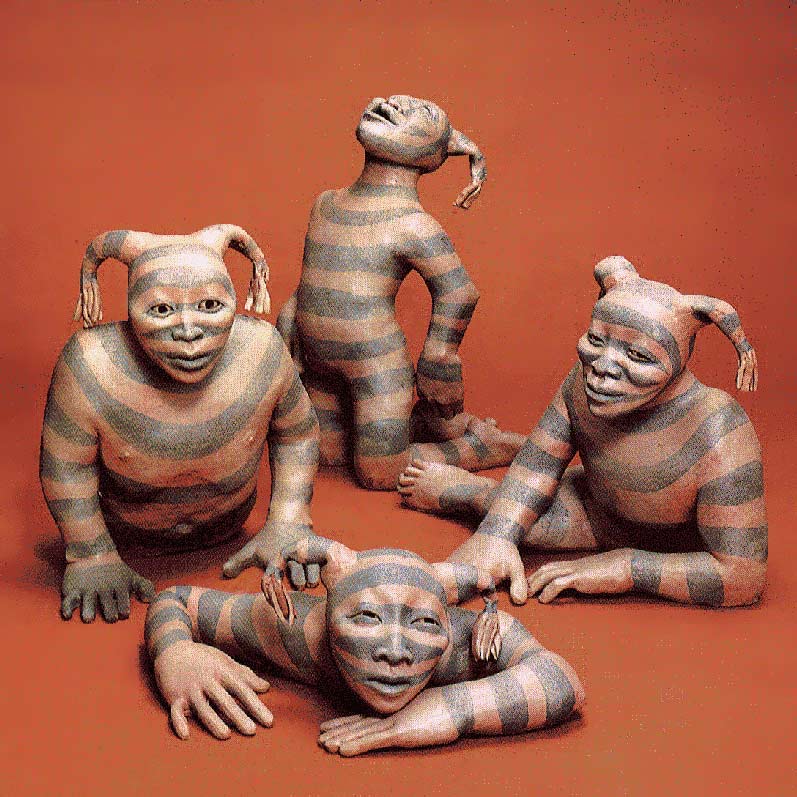The following is an assignment for the UF grad program in art education.
course 6641 Contemporary Issues in Art Education!
Lesson
plan for Visual Culture Discussion Forum
Since
I present my educational programs in a museum environment my lesson
is geared toward the use of the MIM collection. Focusing on the
guitar gallery and the adjacent museum orientation gallery.
 Guitar
gallery MIM
Guitar
gallery MIM Orientation
gallery MIM.
Orientation
gallery MIM.
A
Little background.
Guests
enter the museum obtain their wireless headset system. They can watch
a six minute film about the museum near the orientation gallery which
focuses on the artistry of instrument making. In the middle between
the theater, and the main museum galleries is a u-shaped room depicting
the whole history of the guitar. From the oldest known guitar to a
modern heavy metal doubleneck electric a guest can see the full
evolution of the instrument. In the adjacent room sitars, ouds, and
erhu are examples of near guitar Asian cousins of the European
instrument.
Cross
cultural Aspects
The
opportunity to talk about cultural transmission the way instruments
traveled the Silk Road into the far east made it to America is unique
chance to discuss ways in which the world is connected historically
through musical instruments.
Visual
Culture themes
Instruments
are handmade or manufactured functional works of design. Often inlayed with precious stone, polished shell, or metal they are
fanciful works that can be used as well as viewed. The museum with so
many instruments hanging on walls and simply viewed promotes the idea that someone dreamt the things up brought them to life.
The
plan
A
busload of kids arrives they are broken into groups some take the
standard tour some go to the theater to watch the orientation film
and the final group comes to me at the orientation gallery.
Addressing some of the near guitar instruments and the hand crafted
quality of them, that they come from far off countries, how the
influenced the guitar and focusing on the visual elements the design
aspects of the instruments, a foundation for the program is
presented. Moving into the guitar gallery familiar electric guitars
are seen a humorous display case exhibiting an air guitar and some
very old instruments are visible. In keeping with the ideas of visual
culture items that are contemporary and in truth the kids might even
have at home are contrasted with the old court instruments of the
Renaissance and the folk instruments of the Appalachia.
What
do the instruments say?
After
presenting some history behind the instruments a discussion is opened
up. First about the visual elements why are they pretty or ugly how
are they appealing or boring. What does that mean? The court
instruments are incredibly fancy the old Spanish village instruments
simple plain, opening a chance to discuss class and the
stratification society historically.
What
do these instruments symbolize? Prestige, homespun entertainment,
race, gender?
Moving
to the electric guitars a conversation is presented over the fight
between Gibson guitars versus Fender. Using printed visual aids the
contrasting ad campaigns are presented (a surfer with a playing
Fender while riding a wave vs a concert hall with Les Paul in a
tuxedo playing a gold gilded instrument). Again how are things
marketed? What does a gold plated instrument mean vs a plain beat up
Fender?
Modifications
are everything.
Finally
a beautifully hand painted instrument is presented to state that a
guitar can be a canvas.
visit the MIM website and find out how you can get involved and support this new national treasure.




